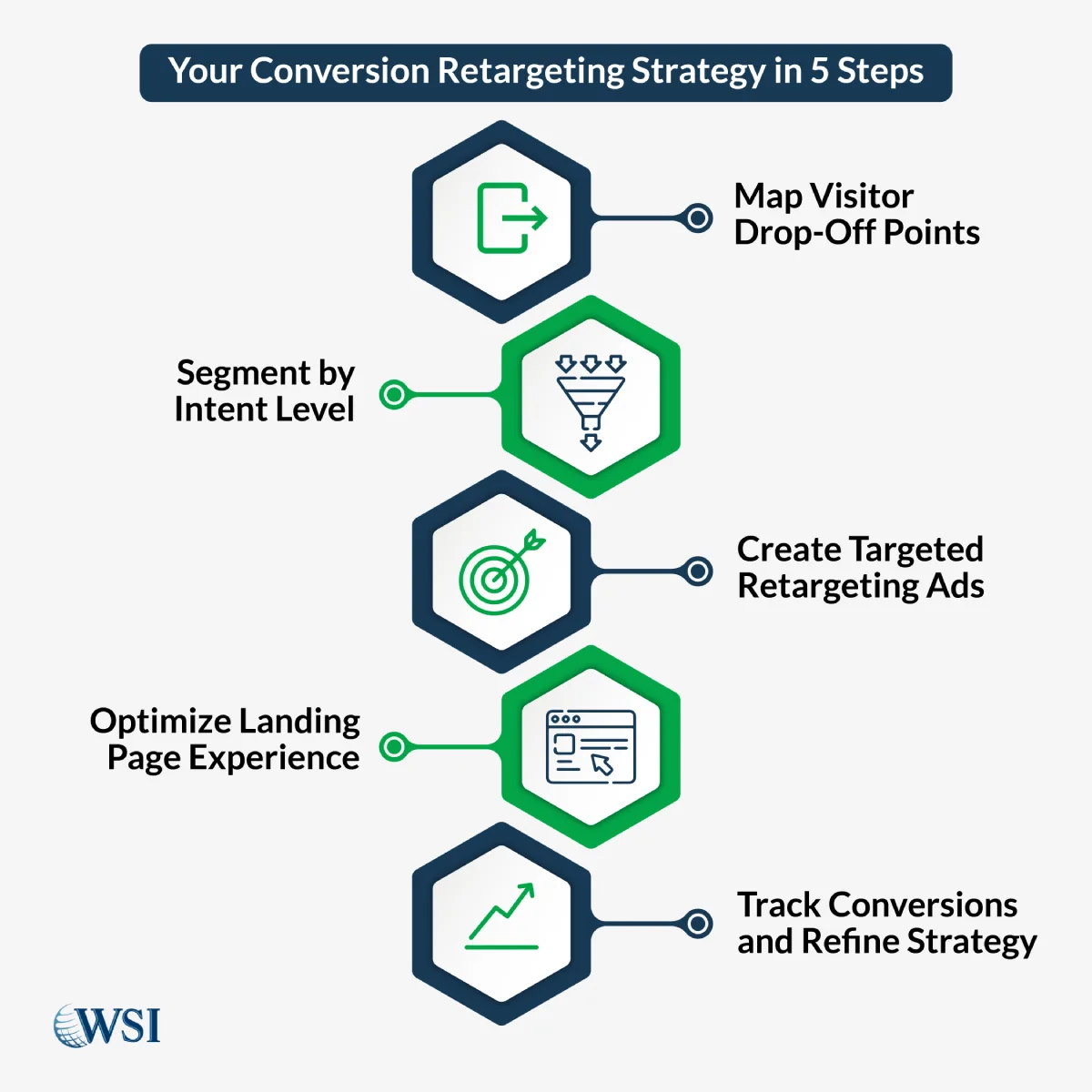CRO retargeting is the process of turning lost visitors into paying customers by optimizing how and when you re-engage them. Most website visitors leave without taking action, often because timing, context, or confidence aren’t quite right. With a well-built conversion retargeting strategy, you can bring them back, guide them through the buyer journey, and increase overall ROI. This article explains why users leave, how remarketing for CRO works, and the exact steps to optimize retargeting campaigns that convert abandoned visitors into loyal customers.
Key Takeaways:
- CRO retargeting helps recover lost visitors by combining conversion data with strategic remarketing.
- Matching ad messaging with optimized landing pages significantly improves conversion rates.
- Tracking and refining conversion events across platforms reveals real ROI growth opportunities.
Contents
- 1 Why Most Visitors Leave Without Converting
- 2 What Retargeting Really Is (and Isn’t)
- 3 Identifying Your Highest-Intent Abandoners
- 4 Building Retargeting Funnels That Align With CRO Goals
- 5 Ad Copy and Landing Pages: A Perfect Match Matters
- 6 Tracking Retargeting ROI Using Conversion Events
- 7 FAQ
- 8 Driving Sustainable Growth Through Retargeting
Why Most Visitors Leave Without Converting
Every website, no matter how beautiful, loses visitors. Roughly 97% of first-time visitors leave without converting. They might browse, click around, even add to cart, yet disappear before completing the purchase. The reason often comes down to timing and trust.
Some visitors need more information. They want reassurance before sharing personal details or making a payment. Others get distracted, compare prices elsewhere, or lose focus before finishing the process. These micro-moments are where potential revenue leaks occur.
The issue isn’t always the offer, it’s the experience. A slow page, confusing layout, or unclear value proposition can instantly break user momentum. In CRO terms, these friction points lower the odds of conversion even if the audience is qualified. Identifying these moments is the first step toward reclaiming them through remarketing for CRO.
What Retargeting Really Is (and Isn’t)
Retargeting isn’t just about chasing visitors around the web with repetitive ads. It’s a strategic way to re-engage users who already showed intent but didn’t act. A proper conversion retargeting strategy uses behavioral data, like page views, time spent, or abandoned actions, to craft personalized follow-ups that reignite interest.
It’s also not a one-size-fits-all solution. A visitor who viewed a pricing page deserves a different message than someone who watched a product video. True CRO retargeting these audiences and delivers tailored experiences at each stage of the funnel.
Retargeting succeeds when it feels like a continuation of the user’s experience, not an interruption. Instead of blasting generic ads, the goal is to pick up the conversation where it left off. This subtle shift transforms advertising into value reinforcement, reminding visitors why your offer matters.

Turn Your Visitors Into Customers Faster
Build conversion-focused retargeting funnels that align perfectly with your website goals. Our team can help optimize every stage of your buyer journey.
How CRO and Retargeting Work Together
CRO (Conversion Rate Optimization) and retargeting complement each other like a compass and a map. CRO ensures your website converts efficiently; retargeting ensures you bring back the right people to experience those improvements again. The result is compounding ROI.
You can think of CRO retargeting as a performance loop. Traffic fuels insights. Insights drive optimization. Optimization increases conversions, which then powers smarter remarketing.
Here’s how the synergy works:
- Behavioral Data: CRO tools identify why users leave. Retargeting campaigns use that data to re-engage them with precision.
- A/B Testing Feedback: Winning ad copy from retargeting can influence website headlines or CTAs, creating consistent messaging.
- Personalized Funnels: CRO segmentation guides how remarketing lists are structured, ensuring the right message hits the right user.
- Continuous Feedback Loop: Retargeting results feed back into CRO experiments, refining the user experience in real time.
Identifying Your Highest-Intent Abandoners
Not every visitor deserves equal attention. Some clicked by accident, while others seriously considered converting. Focusing your remarketing budget on high-intent abandoners maximizes efficiency and return.
You can identify these visitors by analyzing specific behaviors, scroll depth, time on page, cart value, and interactions. The longer and more engaged their session, the higher their intent. These metrics indicate readiness to buy once the right reminder appears.
Focus on:
- Cart Abandoners: Visitors who reached checkout are your warmest audience. They just need a nudge.
- Form Starters: Users who typed in details but didn’t submit show intent. Re-engage them with reassurance or incentives.
- Pricing Page Viewers: Visitors researching cost already weigh options. Offer clarity or urgency through retargeting ads for conversions.
- Repeat Visitors: Multiple sessions often mean lingering interest. Tailored remarketing for CRO keeps them engaged until they’re ready to act.
Building Retargeting Funnels That Align With CRO Goals

A retargeting funnel should mirror your conversion funnel, it’s not a chase; it’s a guided return. You’re designing a sequence that brings prospects back, step by step, based on their intent and previous actions. Each touchpoint must feel natural, timely, and consistent with your CRO objectives.
Below is your conversion retargeting strategy in 5 steps, visually represented in the infographic. Each step builds upon the last to help you create retargeting campaigns that turn abandoned visitors into paying customers.
1. Map Visitor Drop-Off Points
Start by identifying where visitors lose momentum. Is it the product page, pricing table, or checkout form? Mapping these drop-off points helps reveal friction that causes abandonment. Use heatmaps, analytics, and event tracking to understand where and why users leave, then tag these pages for retargeting entry points.
2. Segment by Intent Level
Every visitor shows different intent signals. Some are just browsing; others nearly converted. Segment them based on their engagement level, such as time on site, number of sessions, or actions like cart additions. High-intent segments deserve more aggressive remarketing for CRO, while low-intent visitors need light-touch awareness ads to keep your brand visible.
3. Create Targeted Retargeting Ads
Once you know intent levels, tailor your ad messages accordingly. Cart abandoners might see urgency-driven offers (“Still thinking it over? Your discount expires tonight”), while top-funnel visitors respond better to educational content. Using dynamic ad formats ensures every visitor sees what’s most relevant, helping you optimize retargeting campaigns for higher conversion.
4. Optimize Landing Page Experience
After a user clicks a retargeting ad, the landing page becomes the make-or-break moment. The messaging must align perfectly with the ad promise, both visually and verbally. Reduce friction by removing extra fields, decluttering design, and reinforcing trust signals like reviews or guarantees. The smoother the experience, the higher the conversion rate.
5. Track Conversions and Refine Strategy
No campaign is ever perfect from launch. Use tracking pixels and event data to measure click-throughs, sign-ups, and purchases. Then refine. Improve creative, timing, or frequency based on results. CRO retargeting thrives on iteration, the more you learn, the stronger your funnel becomes.
By executing these five steps consistently, you move beyond simple ad retargeting and into a full conversion retargeting strategy that improves ROI, strengthens brand recall, and delivers measurable growth.
Ad Copy and Landing Pages: A Perfect Match Matters
When someone clicks a retargeting ad, expectations are set. The landing page must meet those expectations instantly. A mismatch between ad promise and page content breaks trust and kills conversions.
Strong alignment starts with message continuity. The same phrase, offer, and visual style should flow from the ad into the landing page. If your ad says “Save 20% Today,” the landing page should echo that line near the CTA. Small consistencies make big differences in CRO retargeting outcomes.
Visual hierarchy matters as well. Visitors arriving from retargeting ads already know your brand. You don’t need to re-educate them; you need to remove friction. Simplify forms, shorten copy, and focus attention on the action you want them to take. The smoother the path, the higher the conversion rate.
Tracking Retargeting ROI Using Conversion Events
To prove the impact of CRO retargeting, you need clear data on what’s working. Tracking conversion events, like form submissions, purchases, or downloads, creates the foundation for accurate ROI analysis.
Set up tracking pixels on every critical page. Connect them to analytics platforms that tie ad impressions to actions. This level of visibility helps identify which audiences, messages, and offers drive the most conversions.
Analyzing this data reveals where optimization can happen next. For example, if retargeting ads for conversions perform better on mobile than desktop, invest more there. If abandoned visitor recovery improves with a certain creative, test variations of that success. Every insight feeds your next campaign cycle.
Retargeting Platforms: Google, Meta, YouTube, and More
Different platforms serve different parts of your audience. Using multiple networks ensures your remarketing for CRO reaches users wherever they spend time online. Each platform has its own strengths, targeting precision, and creative format.
Google’s Display Network captures wide visibility through banner and dynamic product ads. Meta’s platforms, Facebook and Instagram, excel at visual storytelling and engagement. YouTube combines video influence with search intent, delivering a hybrid of awareness and conversion potential.
Here’s a quick comparison for easy reference:
| Platform | Best Use | Ad Format | Primary Strength |
| Google Ads | Dynamic product retargeting | Display & responsive ads | Broad reach with intent targeting |
| Meta (Facebook & Instagram) | Mid-funnel nurturing | Carousel & video ads | Emotional engagement and social proof |
| YouTube | Awareness retargeting | Skippable & non-skippable video | Visual storytelling and brand recall |
| B2B remarketing | Sponsored posts & InMail | Targeting by job title and industry | |
| X (Twitter) | Interest-based re-engagement | Promoted tweets | Quick visibility among trend-focused users |
Diversifying platforms ensures consistent exposure across touchpoints, which increases recognition and improves retargeting performance over time.
FAQ
How long should I run retargeting campaigns for CRO?
Retargeting works best as an ongoing process rather than a short burst. You can rotate creatives every few weeks to prevent ad fatigue, yet maintain continuous presence. The longer the data runs, the more accurate your optimization decisions become.
What’s the difference between remarketing and retargeting?
Remarketing typically refers to re-engaging past customers through email or direct contact. Retargeting uses paid ads to reach people who visited your website or engaged with your content. When combined, they reinforce each other for stronger results.
Can CRO retargeting help service-based businesses?
Absolutely. Service businesses benefit from retargeting just as much as eCommerce. Re-engaging visitors who viewed pricing, booked consultations, or downloaded guides helps recover high-intent leads and shorten the sales cycle.
Driving Sustainable Growth Through Retargeting
CRO retargeting transforms missed opportunities into measurable wins. When executed strategically, it re-engages visitors who already know your value and simply need a final reason to act. Every refined campaign builds brand familiarity, boosts conversion rates, and compounds long-term ROI.
By aligning your retargeting ads with optimized landing pages, personalized funnels, and accurate event tracking, you create a performance loop that keeps improving with every visitor. The result is sustainable revenue growth and stronger digital resilience. If you’re ready to turn lost clicks into new customers, speak with a WSI expert today.

Build a Retargeting System That Drives Real ROI
From Google to Meta, we design and manage data-driven remarketing campaigns that align with your CRO goals and grow conversions.

